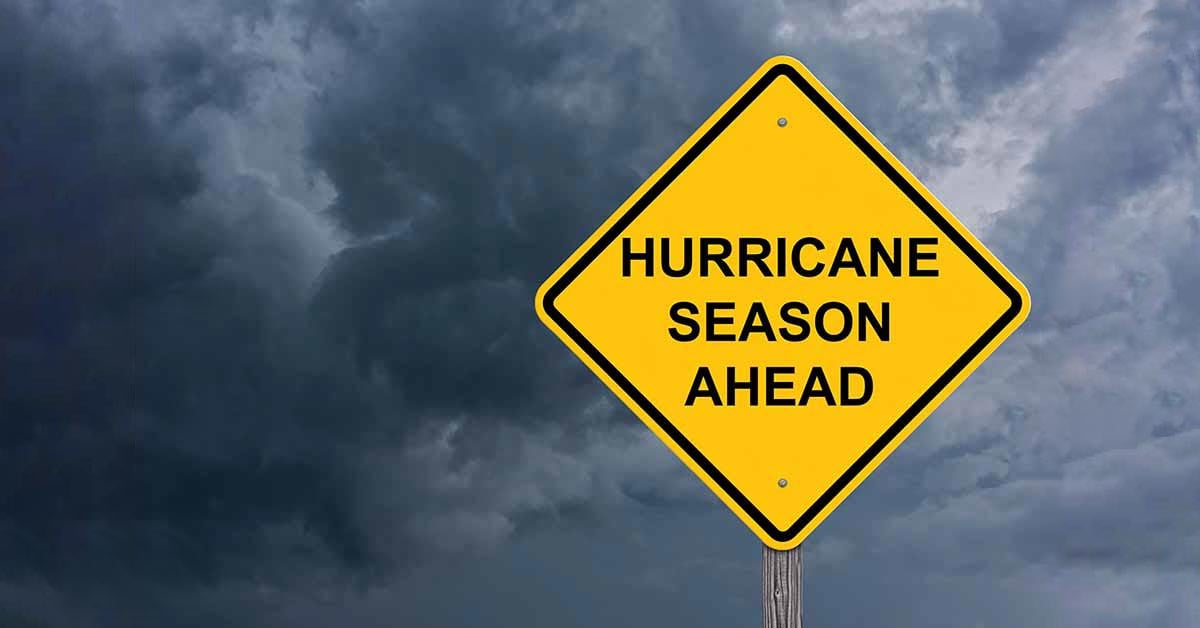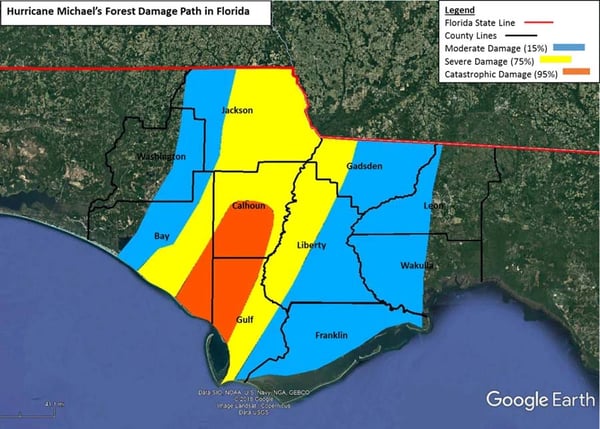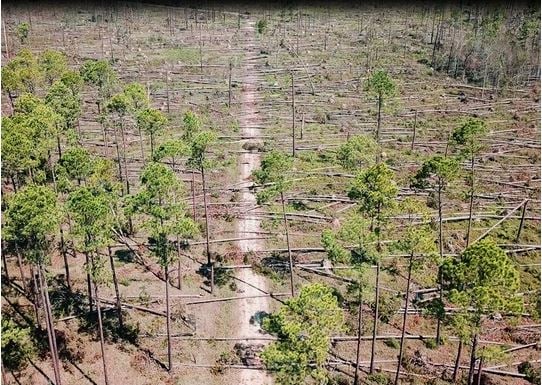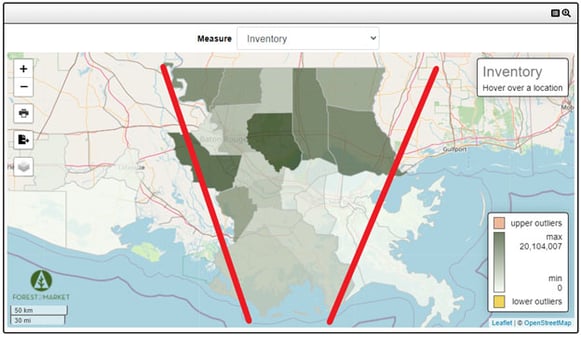
June 1 marked the official start of the hurricane season. What risks will the forestry industry potentially face?
Hurricanes can impact timber and forestry in multiple ways. These include:
- High winds knocking over, uprooting and otherwise damaging trees.
- Flooding from rain and storm surge.
- Slow tree death from excess salt in the soil.
- Saturated ground delaying or preventing harvest.
- Washing out of access roads.
- Destruction of harvesting equipment, trucks and mills.
Long-term effects after a hurricane can also lead to decreased outcomes on important forest benefits. Examples include water filtration through a forest and lower stored carbon in the trees.
With climate change yielding a rise in stronger hurricanes, foresters need to recognize these risk factors. The best way to do that is with a sound understanding of what to expect for this— and every—season.
2023 Atlantic Hurricane Season
On the eastern seaboard of the US, the hurricane season looks about average. According to the NOAA, you can expect a "near normal" level of storms this year.
That amounts to anywhere from 12 to 17 named storms where wind is measured at 39 MPH or greater. From those, 5 to 9 could turn into hurricane-level storms with winds of 74 MPH. And up to 4 of those have potential to become major hurricanes (Category 3, 4 or 5 with winds at 111 MPH or more).
The prospect of an “average” hurricane season may seem like a relief. But don’t let the term create any false sense of safety.
All it takes is one major storm to cause billions in damage. For example, last year’s season was also average in terms of named systems. But Hurricane Ian, a Category 5 monster, caused immense damage.
Estimated losses in the forestry industry from Ian amounted to $32.7 million in Florida alone. Further impacts of the storm negatively affected other southern states as well.
2023 Pacific Storm Season and Forestry Risks
The NOAA’s Climate Prediction Center reported an over 50% chance of higher-than-average Pacific storm activity.
Across the season, the NOAA forecasts 4 to 7 cyclones in the central Pacific hurricane region. These storms include tropical depression and winds up to hurricane-level.
The forecast includes a wide expanse across the Pacific basin. Data is not particular to PNW growing regions. But hurricane impacts often occur far beyond where any given storm makes landfall.
Besides the factors mentioned above, the PNW is also highly vulnerable to wildfires. Hurricanes increase that risk by making forests even more prone to wildfires.
After a storm damages forestland, the dried-out wood debris increases. Large groups of fallen trees open spots in the forest canopy. The openings and increased debris can produce channels for wind to fuel the fires.
With the rising concern over climate change and wildfires, hurricanes create even greater threats for PNW foresters. That’s why having the right data and insights is so critical.
The Effects of Past Hurricanes on Forestry
Besides Hurricane Ian already mentioned above, how have recent hurricanes affected forestlands? Let’s look at a few of the more recent events reported by Forest2Market from ResourceWise.
Hurricane Michael
Hurricane Michael, a Category 5 storm, was the strongest to hit land since Hurricane Andrew in 1992.
Making landfall on the Florida panhandle on October 10, 2018, the storm caused immense devastation in its wake. NOAA data reported that over 3.5 million acres of timberland felt the force of this hurricane.
Nearly half of these damaged acres were denoted as severe or catastrophic. This means the areas had 75% to 95% total timber loss.
The map below shows the varying levels of damage to forestland where Michael initially hit in the panhandle.

The overall effects of the damage were grave. Over 4,300 square miles (2.7 million acres) were damaged. Calhoun County saw the worst of it with 84% inventory damage. On average, 39% of the studied areas had some level of destruction.
Hurricane Laura
Striking Louisiana as a Category 4 storm on August 27, 2020, Hurricane Laura saw wind gusts upward of 150 MPH. The state had not seen winds this high since the 1850s.
Winds were the main culprit of Laura’s serious forest destruction seen across the state.

(Damaged Louisiana forest from the high winds of Hurricane Laura.)
Per LSU AgCenter numbers, these high winds and storm surge caused over $1.1 billion of losses across Louisiana forestry. An extensive 757,000+ acres of timber were destroyed in both national forestland and private stands.
Hurricane Ida
Category 4 Ida also hit the Louisiana coast on August 29, 2021. Next to Katrina, it became the second-most destructive storm in the state to date.
Ida’s storm surge created major flooding throughout the state. This, alongside heavy rains, led to extreme damage to the state’s timberlands.

(Hurricane Ida path on a map of timber supply inventory from SilvaStat360’s Timber Supply Analysis tool.)
Data from the LSU Ag Center estimated forestry costs for Hurricane Ida at $315 million. Over 167,000 acres were damaged with 57,000+ acres classified as very severe damage.
The damage was compounded in Louisiana thanks to a heavy rainy season leading up to it. This meant looser soil and weaker trees.
A feature from the local Daily Star in Hammond, LA highlighted the problem. “This time, the ground was so wet that [the trees] just fell over. Before Hurricane Ida made landfall, 82 inches of rain had already fallen in the Husser area this year. Ida brought over 20 more inches of rain… bringing the amount of rain this year well over 100 inches.”
How to Plan and Respond to Seasonal Hurricane Threats

At this point in the season, foresters don’t have much they can do besides following a “wait and see” perspective for hurricanes. The NOAA and other groups can only extend predictions so far. How and where hurricanes will inevitably hit remains uncertain.
Despite the uncertainty, there are a few mitigating steps to lower the overall danger to a forest.
1. Have a sound forest management plan with forest thinning.
Managed timberlands require careful analysis and care by educated and experienced professionals. As a result, they can strengthen forests against extreme weather threats.
Forest thinning can decrease the risk and catastrophic effects from wildfires. And properly managed forests can also provide similar resilience against hurricanes.
2. Grow some trees in your stand that are stronger against hurricanes.
Overcoming a feeling of helplessness can start within your forestlands. As a long-term goal, you can cultivate a stand with trees more resistant to hurricane damage.
For instance, the American Forest Foundation recommends using longleaf pine as they are stronger against hurricanes. Similarly, live oak and bald cypress trees are somewhat sturdy against strong winds.
This step certainly carries a long-term outlook for success. However, with the continued rise in extreme weather events, investing in your future is a wise decision.
3. Assess the current state of your timber resources.
When planning for natural disasters like hurricanes, you need to take some time for analytics.
Damage like this can impact the industry for many years. Stand owners need to get a sense of what they’re facing and plan a potential response.
Examples of planning include a full inventory of standing timber and losses. Salvage harvest response strategies should be set up ahead of time. Mills must have alternative procurement zones in case of local hurricane effects.
Other important questions to ask yourself include the following:
- What is the total volume of timber resources?
- What are the types and age classes of those timber resources?
- What are the growth and removal rates for the resources?
- What is the actual demand for the resources?
- What is the projected demand (for both storm and non-storm damage)?
- How sustainable is growth for this stand?
- What are current and historical prices for these resources?
SilvaStat360: Your Partner for Forestry Data
Perhaps the most important question you should ask is “how can I prepare for something as uncertain as a hurricane?”
The answer to this question comes through analysis of data and projecting various outcomes. To do this, you need the right tools with the best possible data.
SilvaStat360 from ResourceWise is your partner through this process. The platform offers a wealth of tools such as the Stumpage360 database and Timber Analysis 360.
The information provides a support system for your planning and projection. You can view historical data from previous hurricanes to understand the long-term effects. You can also assess how to best respond in uncertain conditions.
As a neutral intelligence agency, ResourceWise remains outside the timber market itself. The company does not buy or sell timber and does not manage any forestlands. Instead, we serve as an independent provider of expertise and data.
Our experience within these markets has created decades-long partnerships across all major timber regions. You can trust our data and insights to empower all your key decisions.
Schedule a demonstration today to see how ResourceWise and SilvaStat360 can help your business.





